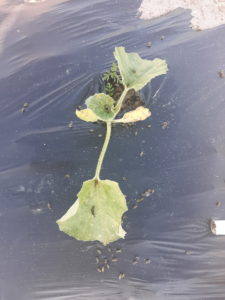I know this may not come as a surprise to most of you, but it is rare that we get to observe the effectiveness of insecticides in such a dramatic way as we encountered when visiting a melon grower in southern IN recently. And in this case, the decision to apply an insecticide at transplant was a good one. In the photo below (Figure 1), one can see an accumulation of dead striped cucumber beetles that have fed upon a cantaloupe seedling that was treated with an imidacloprid soil drench (Trade names include: Admire Pro®, Macho®, Midashe Forte®, Montana®) at transplant 14 days prior to the photo being taken. The beetles are dead because they fed upon the cantaloupe plant and ingested the imidacloprid. Therefore, the plants were protected from defoliation by the beetles, but what about bacterial wilt? Did the act of feeding, however brief, cause bacterial wilt to be transmitted?

Figure 1: Striped cucumber beetles can be found dead after feeding on a cantaloupe plant that has been treated with an imidacloprid product.
The pathogen, Erwinia tracheiphila, which causes bacterial wilt in cucurbits is transmitted by cucumber beetles, primarily striped but also spotted. The bacteria need an opening to enter the plant and can do this through a feeding wound. It also needs a moist substrate to live in until it enters the plant. In the case of the insect vectors, this is their frass (aka insect poop). The bacteria reside in the gut of the beetles and when the beetles defecate on the plant, this is the source of inoculum that starts infection. In this field, the beetles died before any visible frass was deposited on the leaves, so these plants are most likely protected. That is, the beetles fed on the plant and died before defecating. The result was that the bacterium that causes bacterial wilt was not transmitted.
Imidacloprid is one compound from the neonicotinoid group of insecticides. They are water soluble and therefore move quickly into the plant from the soil drench and into the xylem tissues. As soon as the plant ‘takes a drink’ it is carried into the vascular tissues. One study measured lethal amounts of imidacloprid in floral tissues of buckwheat within one day of application killing parasitoid wasps that feed on flowers (Krischik, Landmark and Heimpel 2007, Environmental Entomology). Because of its solubility in water, we can expect older leaf parts and shoots of the plant to be better protected through this application while we find less residues in storage organs, roots and fruits (Sur and Stork 2003, Bulletin of Insectology).
Take heed, though, because some of our own work at Purdue has shown that these chemicals linger in the plant through bloom and are present in concentrations that are deleterious to honey bees. Regardless of application rate (low vs. high label) soil drenches of imidacloprid and thiamethoxam (such as Admire Pro® and Platinum®) can be detrimental to the pollinators that we rely on in these systems.
The take-home message? If you grow cantaloupe in a region with high pest pressures early in the season, it may be beneficial to apply an insecticide to protect young seedlings from feeding and disease. Choose a compound like acetamiprid (Assail®) or a pyrethroid at transplant to protect young seedlings and prevent bacterial wilt while minimizing risks posed to pollinators.
References
Vera A. Krischik, Alyson L. Landmark, George E. Heimpel, Soil-Applied Imidacloprid Is Translocated to Nectar and Kills Nectar-Feeding Anagyrus pseudococci (Girault) (Hymenoptera: Encyrtidae), Environmental Entomology, Volume 36, Issue 5, 1 October 2007, Pages 1238–1245, https://doi.org/10.1603/0046-225X(2007)36[1238:SIITTN]2.0.CO;2
Robin Sur and Andreas Stork, Uptake, translocation and metabolism of imidacloprid in plants, Bulletin of Insectology, Volume 56, Issue 1, January 2003.